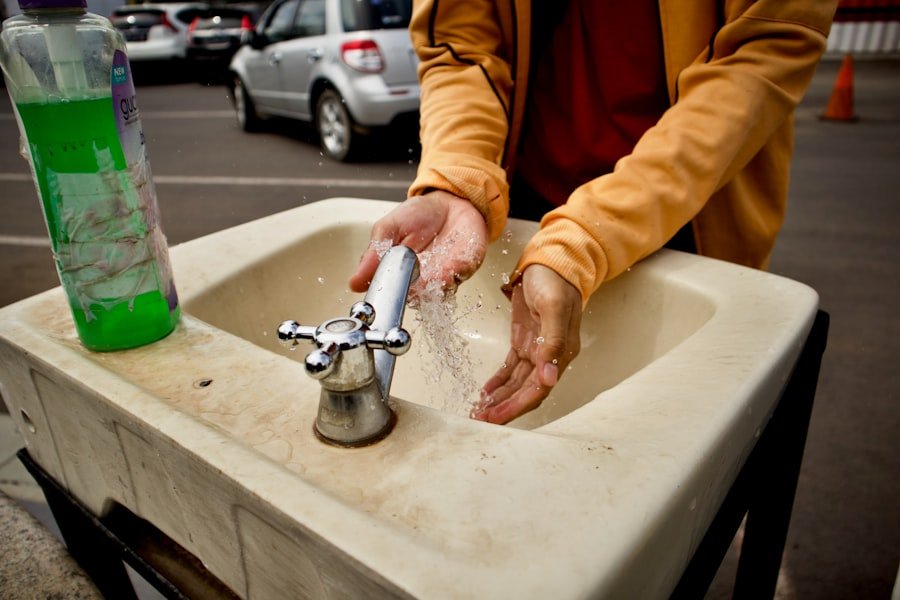Folliculitis is a common skin condition that occurs when hair follicles become inflamed, often due to infection. This inflammation can arise from various factors, including bacteria, fungi, or even irritation from shaving and friction. As we delve into the intricacies of folliculitis, we find that it can manifest in different forms, such as superficial folliculitis, which affects only the upper part of the hair follicle, and deep folliculitis, which penetrates deeper layers of the skin.
Understanding these distinctions is crucial for effective treatment and management. The condition can affect anyone, regardless of age or skin type, and it often presents itself in areas where hair grows, such as the scalp, face, arms, and legs. While folliculitis is generally not serious, it can lead to discomfort and self-consciousness.
By familiarizing ourselves with the underlying causes and types of folliculitis, we can better equip ourselves to recognize its symptoms and seek appropriate treatment when necessary.
Key Takeaways
- Folliculitis is a common skin condition caused by inflammation of hair follicles.
- Symptoms of folliculitis include red, swollen, and itchy skin, often with pus-filled bumps.
- Home treatments for folliculitis include warm compresses, gentle cleansing, and avoiding tight clothing.
- Over-the-counter medications like benzoyl peroxide and hydrocortisone cream can help treat mild folliculitis.
- Severe folliculitis may require prescription medications like oral antibiotics or antifungal creams.
Recognizing the Symptoms of Folliculitis
Identifying the symptoms of folliculitis is essential for timely intervention. The most common signs include small red bumps or white-headed pimples around hair follicles, which may resemble acne. These bumps can be itchy or tender, causing discomfort that prompts us to examine our skin more closely.
In some cases, we may notice pus-filled blisters that can burst and crust over, indicating a more severe infection. In addition to these visible symptoms, we might experience localized pain or tenderness in the affected areas. If we observe these signs on our skin, it’s important to take note of any changes in severity or spread.
While folliculitis can often resolve on its own, recognizing these symptoms early can help us avoid complications and seek appropriate care if needed.
Treating Folliculitis at Home

For mild cases of folliculitis, home treatment can be effective in alleviating symptoms and promoting healing. One of the simplest methods involves keeping the affected area clean and dry. We can gently wash the area with mild soap and warm water to remove any irritants or bacteria that may be contributing to the inflammation.
After cleansing, applying a warm compress can help soothe discomfort and reduce swelling. In addition to basic hygiene practices, we might consider using over-the-counter topical treatments containing ingredients like benzoyl peroxide or salicylic acid. These products can help reduce inflammation and prevent further breakouts.
However, it’s essential to use these treatments sparingly and follow the instructions on the packaging to avoid irritating our skin further.
Over-the-Counter Medications for Folliculitis
When home remedies are insufficient, over-the-counter medications can provide additional relief for folliculitis. We may find topical antibiotics particularly useful in treating mild bacterial infections associated with this condition. Products containing clindamycin or erythromycin can help combat the bacteria responsible for inflammation and promote healing.
In addition to antibiotics, we might explore anti-inflammatory creams or gels that contain hydrocortisone. These products can help reduce redness and swelling while providing relief from itching. As we navigate our options, it’s important to remember that while over-the-counter treatments can be effective for mild cases, they may not be suitable for everyone.
Consulting with a healthcare professional before starting any new medication is always a wise choice.
Prescription Medications for Severe Folliculitis
In cases where folliculitis is more severe or persistent, prescription medications may be necessary to achieve effective treatment. Our healthcare provider may recommend oral antibiotics if the infection is widespread or does not respond to topical treatments. Commonly prescribed antibiotics include cephalexin or doxycycline, which target the bacteria causing the inflammation.
For individuals with recurrent or chronic folliculitis, our doctor might consider prescribing antifungal medications if a fungal infection is suspected. In some instances, corticosteroids may also be prescribed to reduce inflammation and alleviate symptoms more rapidly. It’s crucial for us to follow our healthcare provider’s instructions closely when taking prescription medications to ensure optimal results and minimize potential side effects.
Preventing Folliculitis

Prevention is key when it comes to managing folliculitis effectively. By adopting certain lifestyle changes and skincare practices, we can significantly reduce our risk of developing this condition. One of the most effective strategies involves maintaining proper hygiene.
Regularly washing our skin with mild soap helps eliminate bacteria and debris that can clog hair follicles. Additionally, we should be mindful of our shaving techniques if we choose to shave areas prone to folliculitis. Using a clean razor and shaving in the direction of hair growth can minimize irritation and reduce the likelihood of ingrown hairs, which can contribute to folliculitis.
By incorporating these preventive measures into our daily routines, we can take proactive steps toward healthier skin.
Proper Skin Care for Folliculitis Prevention
In our quest to prevent folliculitis, establishing a proper skincare routine is essential. We should prioritize using non-comedogenic products that won’t clog our pores or exacerbate existing skin issues. This includes selecting moisturizers and sunscreens specifically formulated for sensitive skin types.
Exfoliation also plays a vital role in maintaining healthy skin and preventing folliculitis. By gently exfoliating our skin once or twice a week, we can remove dead skin cells that may contribute to clogged hair follicles. However, we must be cautious not to over-exfoliate, as this can lead to irritation and worsen our skin condition.
Hygiene Practices to Prevent Folliculitis
Maintaining good hygiene practices is fundamental in preventing folliculitis from occurring in the first place.
Regularly washing our hands before touching our face or other areas prone to folliculitis is crucial in minimizing the transfer of bacteria.
Additionally, we should avoid sharing personal items such as towels or razors, as this can facilitate the spread of infection.
After exercising or sweating heavily, it’s important for us to shower promptly to cleanse our skin of sweat and bacteria that may have accumulated during physical activity. Wearing loose-fitting clothing made from breathable fabrics can also help reduce friction against our skin, further decreasing the risk of developing folliculitis.
Lifestyle Changes to Prevent Recurring Folliculitis
To effectively prevent recurring folliculitis, we may need to make some lifestyle changes that promote overall skin health. For instance, managing stress levels through relaxation techniques such as yoga or meditation can have a positive impact on our skin’s condition. Stress has been known to exacerbate various skin issues, including folliculitis.
Additionally, maintaining a balanced diet rich in vitamins and minerals can support healthy skin from within. Foods high in antioxidants, such as fruits and vegetables, can help combat inflammation and promote healing. Staying hydrated by drinking plenty of water is also essential for maintaining optimal skin health.
When to Seek Medical Attention for Folliculitis
While many cases of folliculitis resolve on their own with proper care, there are instances when seeking medical attention becomes necessary. If we notice that our symptoms are worsening or not improving after a few days of home treatment, it’s time to consult a healthcare professional. Additionally, if we experience fever or significant pain in conjunction with our symptoms, this could indicate a more serious infection requiring medical intervention.
We should also be vigilant about any signs of complications arising from folliculitis, such as the development of abscesses or cellulitis—an infection of the deeper layers of skin. Prompt medical attention in these cases is crucial to prevent further complications and ensure effective treatment.
Complications of Untreated Folliculitis
If left untreated, folliculitis can lead to several complications that may impact our overall health and well-being. One potential complication is the formation of painful abscesses—collections of pus that develop beneath the skin’s surface. These abscesses may require drainage by a healthcare professional and could lead to scarring if not addressed promptly.
Another concern is the risk of cellulitis, a more serious bacterial infection that affects deeper layers of skin and surrounding tissues. Cellulitis can cause significant pain, swelling, and redness in the affected area and may require intravenous antibiotics for treatment. By understanding these potential complications associated with untreated folliculitis, we are better equipped to recognize when it’s time to seek medical attention and take proactive steps toward maintaining healthy skin.
If you are looking for more information on hair-related issues, you may want to check out this article on causes, symptoms, and treatment options for hair loss. It provides valuable insights into the various factors that can contribute to hair loss and offers potential solutions to address this common concern.
FAQs
What is folliculitis?
Folliculitis is a common skin condition characterized by inflamed hair follicles. It can occur anywhere on the body where hair follicles are present and is often caused by bacterial or fungal infections.
What are the symptoms of folliculitis?
Symptoms of folliculitis may include red, swollen, and itchy skin around the hair follicles, pus-filled bumps, and sometimes, blisters that break open and crust over.
How is folliculitis treated?
Mild cases of folliculitis can often be treated with over-the-counter topical medications, such as antibacterial or antifungal creams. More severe cases may require prescription oral antibiotics or antifungal medications.
How can folliculitis be prevented?
To prevent folliculitis, it is important to practice good hygiene, avoid tight clothing that may irritate the skin, and keep the skin clean and dry. Using a clean razor and avoiding sharing personal items that come into contact with the skin can also help prevent folliculitis.
When should I see a doctor for folliculitis?
If the symptoms of folliculitis persist for more than a few days, worsen, or are accompanied by fever or other signs of infection, it is important to see a doctor for proper diagnosis and treatment.


